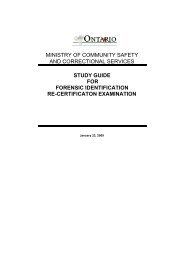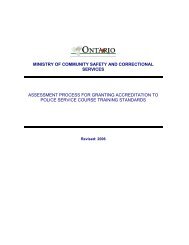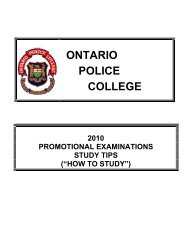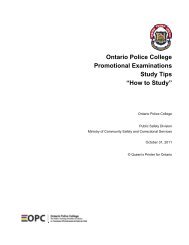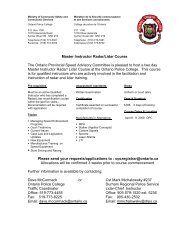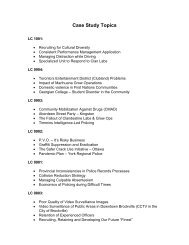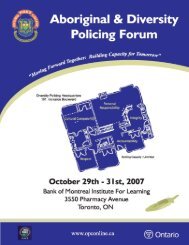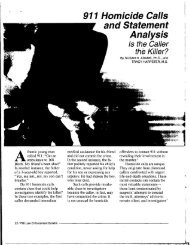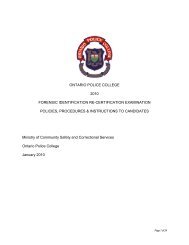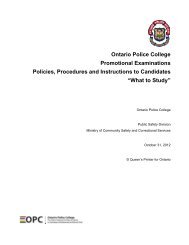General Study Guide - Ontario Police College
General Study Guide - Ontario Police College
General Study Guide - Ontario Police College
You also want an ePaper? Increase the reach of your titles
YUMPU automatically turns print PDFs into web optimized ePapers that Google loves.
E- Evaluation: It is not sufficient that the comparison disclose similarities or dissimilarities in<br />
properties or characteristics. Each characteristic will have a certain value for identification<br />
purposes, determined by its frequency of occurrence. The weight or significance of each must<br />
therefore be considered.<br />
V –Verification: It (scientific method) insists upon verification as the most reliable form of proof.<br />
Insp. Roy Huber, Identification News Nov. 1962<br />
A- analyze - The first step, analysis, requires the expert to examine and analyze all variables<br />
influencing the friction ridge impression in question. This begins with an understanding of friction<br />
ridged skin and the transition of the three dimensional skin structure to a two dimensional image.<br />
When examining latent fingerprints, several factors must be accounted for and understood. Some of<br />
these factors are the material upon which the latent print has been deposited (substrate distortion),<br />
the development process(es), pressure distortion, and external elements (blood, grease, etc.,<br />
different types of matrix distortion). Clarity of the print should be assessed and level of tolerance for<br />
discrepancies considered. The quantity and quality of the latent print ridges influences the<br />
examiners ability to perform the next phase. The conclusion of the analysis process is a<br />
determination as to whether sufficient information exists to proceed to the next phase.<br />
C- compare - The comparison process introduces the known exemplar with which the latent print is<br />
to be compared. At this point, there is also another analysis phase taking place. This analysis is of<br />
the known exemplar in an effort to determine the suitability for achieving the conclusion stated<br />
above. It is possible that the known exemplar may contain fingerprint images that are too heavily<br />
inked or smudged, and thereby unreliable, thus preventing a conclusive comparison. The<br />
comparison process begins with determining the general ridge flow and shape (Level 1 Detail) in an<br />
effort to properly orient the latent print with a corresponding area of the known exemplar<br />
fingerprints. This is generally followed by selecting key focal characteristics (Level 2 Detail),<br />
understanding their position, direction and relationship and then comparing this formation with the<br />
formations in the known exemplar. The quality and quantity of this information directly affects the<br />
ease or difficulty of this process.<br />
E- evaluate - The result of the comparison is the evaluation process or making a conclusion. The<br />
general fingerprint community refers to the conclusions drawn as being one of three choices. First,<br />
the two impressions (latent fingerprint and the known fingerprint) were made by the same finger of<br />
the same person. Second, the latent impression was not made by any of the fingers of the exemplar<br />
fingerprints. And third, a conclusive comparison could not be achieved, generally due to the lack of<br />
adequate clarity or the absence of comparable area in the known exemplar. In order to establish an<br />
identification decision, this process must insure that all of the fingerprint details are the same and<br />
maintain the same relationship, with no existing unexplainable differences.<br />
V- verify - The final process is verification. The general rule is that all identifications must be verified<br />
by a second qualified expert. This verification process by a second examiner is an independent<br />
examination of the two fingerprint impressions (latent fingerprint and known exemplar fingerprint)<br />
applying the scientific methodology of analysis, comparison and evaluation described above.



